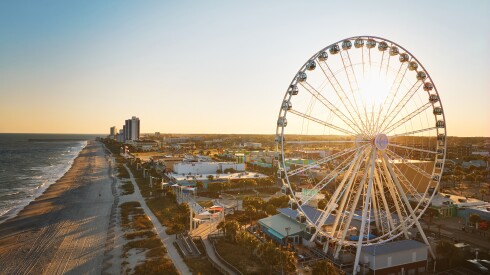In the first season of HBO Max’s Emmy-winning The Gilded Age, the women of the Van Rhijn family discuss the invitation of social climber Bertha Russell to an upcoming party in Newport, Rhode Island. “She’s muscling into New York. She was bound to jam her foot in the door of Newport,” says matriarch Agnes van Rhijn, underscoring the first-class status the coastal New England city granted to those who were accepted into its social scene.
During the Gilded Age—a period of American history from about 1870 to 1900, marked by explosive growth in industry and technology, and the extravagance of those who profited off its working class—Newport was the summer playground for the 1 percent. New York’s business tycoons and robber barons one-upped each other with larger and larger “cottages,” sprawling oceanfront mansions that sprouted along Bellevue Avenue and Ocean Drive. Summering in Newport wasn’t a vacation; it was a marketing ploy, a way to stay at the top of the most elite circles.
Fortunately, when that bubble popped, many of these mansions and landmarks were preserved, making much of Newport feel caught in time—and the perfect place to film a period TV series. With season three of The Gilded Age airing now, you could simply watch stars like Christine Baranski, Morgan Spector, and Cynthia Nixon flit about Newport from the comfort of your couch. But you’d be better off visiting and experiencing that Gilded Age glamour for yourself.

The parlor of the Breakers mansion, which was the summer home of the Vanderbilt family.
Photo by Jaclyn Vernace/Shutterstock
Explore Newport’s opulent mansions and deep history
Originally settled by five Indigenous groups (the Narragansetts, Wampanoags, Pequots, Nipmucs, and Niantics), the settlement of Newport was founded in 1639 by English settlers who had followed radical Puritan cleric Anne Hutchinson after her explusion from Boston. The city became one of colonial America’s five most important seaports, with trade—in rum, candles, fish, silver, furniture, and even enslaved people—catapulting Newport into a sphere of affluence.
Because industrialization never took off in Newport, its fresh air, verdant fields, and windswept cliffs made it a popular summer resort destination beginning in the early 19th century. Growth accelerated later in the century as the nouveau riche built monuments to their own wealth. Among them, the Vanderbilts made their fortune in international shipping and in multiple rail lines, including the New York Central and Hudson River railroads. The Berwinds, one of the most powerful families of the period, derived their wealth from a sprawling coal industry. Meanwhile, the Astors, who had amassed a nearly obscene amount of real estate in New York City, became the country’s first multimillionaires by smuggling opium.
To create their fantastical homes, they called on the most fashionable architects of the day, including Richard Morris Hunt, famed for designing the entrance facade and Great Hall of the Metropolitan Museum of Art (built in 1902) and the pedestal of the Statue of Liberty in New York. They also recruited McKim, Mead, and White, who built New York’s original Pennsylvania Station, the Boston Public Library, and Providence’s lofty State House.
“Newport is one of America’s most intact historic communities,” says Rhode Island historian laureate Keith Stokes. “When most people think of historic preservation and early American history, be it the Revolutionary era, the Civil War, or the Gilded Age, they tend to think of New York, Philadelphia, [and other] much larger cities. But really, it’s all here within Newport.”
Portions of all three seasons of The Gilded Age were filmed at the Breakers, Marble House, the Elms, Rosecliff, Chateau-sur-Mer, Hunter House, and Kingscote, all of which operate as house museums. (Many of the characters’ New York mansion interiors were also shot here.) Some contain collections of art by the likes of John Singer Sargent, Giovanni Boldini, Daniel Chester French, Gertrude Vanderbilt Whitney, and Tiffany. Visitors can buy tickets for self-guided tours for single properties; an array of guided tours is available for an additional fee; the Access Pass gives you unlimited admission to the mansions for a year.
Newport Mansions’ three-hour-plus “Inside the Gilded Age” tour will be available on August 15th, 22nd, and 29th, as well as select Tuesdays and Fridays in September. “The tour offers a glimpse of HBO’s filming locations across our properties,” says Nicole Williams, curator at the Preservation Society of Newport County. “Visitors learn about the complex process of filming in our house museums, and how HBO recreated the glamour and drama of the era, with the houses as a grand stage.”
For a peek into women’s rights history, make reservations for afternoon tea at the Chinese Tea House, on the grounds of Marble House, where mansion owner Alva Belmont hosted rallies for suffragettes beginning in 1913. Tea is served on a china set painted with the words “Votes for Women.” Reproductions of the set are available for purchase.
The Newport Historic Society offers a variety of walking tours, including on Gilded Age and African American history. “By the time those mansions were occupied,” says Stokes, “Newport had one of the wealthiest Black communities in America,” thanks to the community’s indispensable trade skills as doctors, dentists, dressmakers, hair stylists, teachers, and more.

The legendary grass courts at the International Tennis Hall of Fame are also featured on The Gilded Age.
Photo by EWY Media/Shutterstock
Experience the Gilded Age outdoors
The International Tennis Hall of Fame, designed by McKim, Mead, and White in 1880, is another filming location for The Gilded Age. According to Catherine DeCesare, a history professor at the University of Rhode Island, “It was a place to see and be seen,” and was the premier social and recreation center for tennis, concerts, billiards, theater, and dining.
The venue is now home of the annual July Hall of Fame Open, the only grass-court tournament played in the U.S. Practice your topspin on the same courts as tennis legends Rafael Nadal and Serena Williams; guest reservations are available ($250 per hour), but you must wear tennis whites.
Polo also rose to popularity in Newport during the Gilded Age, with the Newport Polo Club established in 1876. On Saturdays from June through September, it hosts international tournaments. You can also book a lesson or attend a public exhibition match.
Although many port cities call themselves the sailing capital of the world, Newport’s deep water and reliable winds give it a credible claim to the title. Get out on the harbor aboard a vintage schooner with Newport Classic Cruises. Landlubbers will appreciate Newport Jaguar Tours, which hosts road trips that highlight, among other topics, Gilded Age architecture, gardens, and filming locations from the show.
Don’t miss Green Animals, built in 1860 in neighboring Portsmouth, a town eight miles north. The oldest topiary garden in the United States, it encompasses seven acres planted with arbors, fruit trees, and flowers—including 37,000 spring-blooming tulips, plus lupine, columbine, hydrangeas, daylilies, asters, and dahlias. Its 80 larger-than-life topiary animals, which give the gardens their name, range from bears and stags to elephants and giraffes.
The best views—and sunset photos—in the city undoubtedly belong to the Cliff Walk, a 3.5-mile natural path above the sea with multiple entrance points, which 19th-century vacationers used for fresh-air rambles. The Forty Steps, located at the end of Narragansett Avenue a half mile north of the Breakers, was a popular meeting spot for Gilded Age domestics, especially Irish servants, who gathered there to celebrate St. Patrick’s Day. The community’s descendants still honor the tradition today.
Where to eat and stay in Newport
With a sunny day and your admission ticket to the mansions, you can picnic on the grand estates’ lawns. Stoneacre Picnics offers grab-and-go baskets and full-service packages complete with food (like cheeses and crudites, sandwiches, and cookies), tables, and croquet. Or put together your own alfresco meal with a charcuterie board from Bellevue Boards, wine from Newport Vineyards, and a Caesar salad from Cru Café, all located within about five miles of one another.
Locally made sandwiches, salads, and snacks are available at the Breakers Café, on the premises of the Breakers. Or splurge on dinner at Castle Hill Inn, built in 1875 and now a Relais & Château hotel and restaurant serving high-end New England coastal cuisine, with an emphasis on seafood, and exceptional views of the Atlantic.
Stay at the Vanderbilt, an Auberge luxury property on historic Mary Street. The onetime home of Alfred Gwynne Vanderbilt, son of Cornelius Vanderbilt (who commissioned the Breakers), the hotel features dozens of period-inspired flourishes, from its majestic double staircase to moody oil portraits. The Vanderbilt hosts a weekly Punch Bowl Hour, plus a Cocktails through the Ages workshop, which includes a signature Gilded Age creation.
New England boutique brand Lark Hotels manages three properties in Newport; two of them have a Gilded Age connection. The Cliffside Inn, set in a graceful, late-1800s Victorian mansion, has 17 rooms and suites and an enchanting garden. Meanwhile, Gilded’s color-drenched design presents an homage to vintage style, in a pair of circa-1850 homes, alongside decidedly modern touches like tapas for breakfast.











